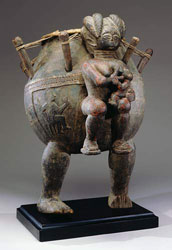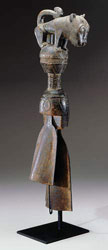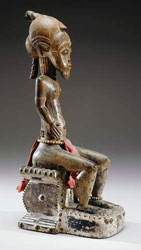

 and Fante people in Ghana, as well as the Baule in Côte d'Ivoire
and Fante people in Ghana, as well as the Baule in Côte d'Ivoire  all speak Akan languages and share many art traditions. Naturalistic carvings of human beings are found in most Akan groups. Among the Baule these figures are carved to serve as the abode of spirits; whereas in Ghana, sculptures are generally associated with political power. Music, dance, textiles, and gold work are the visible expressions of the power of chiefs, especially in Ghana where traditional leaders continue to play a major role in civil life. Among the Fante, neighborhood associations known as "companies" reflect the former military organization of the society. The musical instruments displayed here were used in processions that celebrated the military power of these companies.
all speak Akan languages and share many art traditions. Naturalistic carvings of human beings are found in most Akan groups. Among the Baule these figures are carved to serve as the abode of spirits; whereas in Ghana, sculptures are generally associated with political power. Music, dance, textiles, and gold work are the visible expressions of the power of chiefs, especially in Ghana where traditional leaders continue to play a major role in civil life. Among the Fante, neighborhood associations known as "companies" reflect the former military organization of the society. The musical instruments displayed here were used in processions that celebrated the military power of these companies.The Baule, unlike Akan speakers in Ghana, share masking traditions with their neighbors--the Guro, to the west, and the Senufo, to the north. Among all Akan speakers, the imagery incorporated in carvings, pottery, metal work, and textiles refers to proverbs that give moral instruction.



